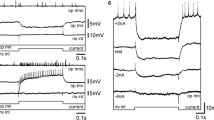Abstract.
In this paper we develop a mathematical model for the electrical activity of the afferent pathway, formed from the coupled primary and secondary sensory neurons. The primary sensory neuron possesses the electrical properties of AH neurons and morphological characteristics of Dogiel type II neurons; the secondary sensory neuron displays the tonic type of electrical behavior and has morphological features of Dogiel type III neurons. Free nerve endings of the mechanoreceptor form the receptive field of the pathway. Based on the general principles of the Hodgkin-Huxley description of excitable cells, the model simulates the following sequence of events: stretch of the receptive field initiates the dendritic potential at the mechanoreceptors; the excitation causes soma action potential development at the primary sensory neuron which is followed by soma action potential generation at the secondary sensory neuron. Numerical calculations have shown that the model is capable of reproducing different electrical patterns within the pathway under normal physiological conditions and after treatment with charybdotoxin, iberiotoxin, tetrodotoxin, ω-conotoxin GVIA, A1–A2 purinoceptor agonists, a protein kinase C activator, and a δ-opioid receptor agonist. Comparison of the computational results with the results of experiments conducted on the neurons of the submucous and myenteric plexi of the small bowel demonstrates their good qualitative and quantitative agreement.
Similar content being viewed by others
Author information
Authors and Affiliations
Additional information
Received: 3 November 1995 / Accepted in revised form: 24 July 1996
Rights and permissions
About this article
Cite this article
Miftakhov, R., Wingate, D. Electrical activity of the sensory afferent pathway in the enteric nervous system. Biol Cybern 75, 471–483 (1996). https://doi.org/10.1007/s004220050312
Issue Date:
DOI: https://doi.org/10.1007/s004220050312




